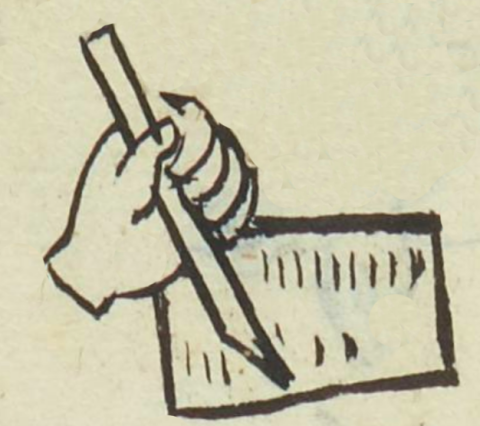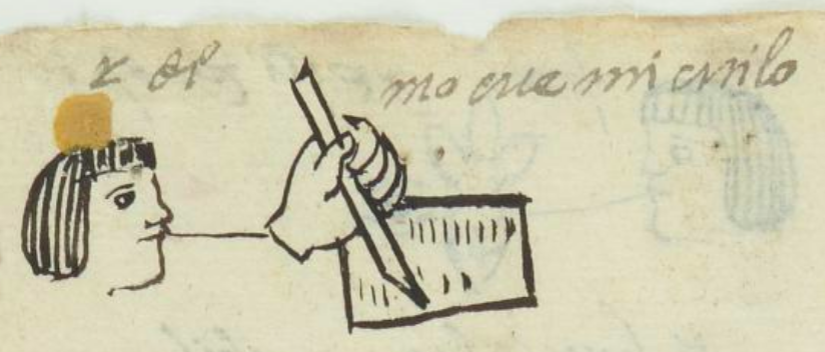Mocuemicuilo (MH521v)
This black-line drawing of the simple glyph for the personal name Mocuemicuilo is attested here as a man's name. It shows a rectangle with marks on it, perhaps representing cuemitl, agricultural furrows or parcel. If the parcel is possessed, this could explain the "mo," for "your." Further, a human fist holding a paintbrush or stylus apparently inscribes, writes, or paints icuiloa) on the field--unless it is really a piece of paper, which could bring an association with icuilolli or tlacuilolli. If this is the case, then the -cuem- requires further explanation.
Stephanie Wood
This glyph is very reminiscent of the glyphs we have designated as tlacuilolli. See additional glyphs for names such as Tlacuilol, Amatlacuilol, cuemicuilo, tetlacuilol, Tlacuilollan, etc. The writing implement and the agricultural implement (e.g., huictli) have a similar look.
Marc Thouvenot identifies the verb icuiloa (or ihcuiloa, with the glottal stop), which means to paint, write, or print, as having a root of -cuil-. He notes how it also appears in tlacuiloliztli (writing), tlacuilo (writer), and cuicuiltic (mottled). He goes on to show various uses of icuiloa that take it beyond the simple definitions just given, resulting in something like the action of creating a design (e.g., on leather, ceramics, sculpture, or in textiles). It can also be something like the action of decorating (e.g., to put a flower on a cup of atole). He associates icuiloa and tlacuilolli with "cultural artifacts," such as arts and crafts or examples of writing and painting, but cuicuiltic with effects created by "nature." This short summary barely does his article justice; it is worth reading the entire piece. How Thouvenot's study might connect with the concept of bent or curved mentioned by Prem (1974: 555, 682) raises an interesting question. Perhaps the bent or curved lines of writing, painting, carving, embroidery, and so on, fall with in the realm of expressions of -cuil-. See
Marc Thouvenot, "Imágenes y escritura entre los nahuas del inicio del XVI," Estudios de Cultural Náhuatl 41 (2010).
Stephanie Wood
dio mocuemicuilo
Diego Mocuemicuilo
Stephanie Wood
1560
Stephanie Wood and José Aguayo-Barragán
write, writing, painting, escribir, inscribir, pintar, paint, escribiendo, pintando, nombres de hombres

mo-, your, https://nahuatl.wired-humanities.org/content/mo
cuemi(tl), agricultural strip or furrow, https://nahuatl.wired-humanities.org/content/cuemitl
icuiloa, to write/paint, https://nahuatl.wired-humanities.org/content/icuiloa
Su Sementera-Se Inscribe(?)
Stephanie Wood
Matrícula de Huexotzinco, folio 521v, World Digital Library. https://www.loc.gov/resource/gdcwdl.wdl_15282/?sp=122&st=image
This manuscript is hosted by the Library of Congress and the World Digital Library; used here with the Creative Commons, “Attribution-NonCommercial-ShareAlike 3.0 License” (CC-BY-NC-SAq 3.0).









